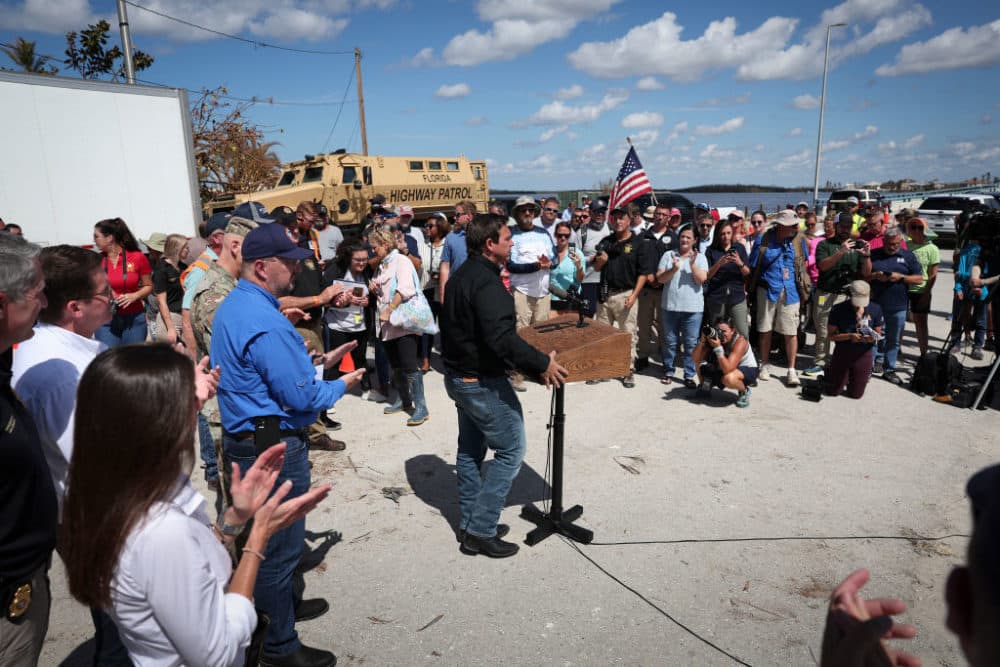Advertisement
Commentary
States like Florida should have to reduce emissions to get disaster relief

Florida’s Gov. Ron DeSantis likes to boast about what he’s done to improve storm resilience and prepare his state for rising sea levels. He gladly accepted over $400 million in federal money for disaster readiness from the Biden administration earlier this year. And many billions more are on the way in the wake of Hurricane Ian.
But when it comes to reducing Florida’s greenhouse gas emissions, DeSantis isn’t interested. “We’re not doing any left-wing stuff,” he said at a press event in late 2021.
The Sunshine State is even more dependent on natural gas for electricity than Massachusetts, and it still generates some of its power with coal.
Massachusetts has a legislated goal to reduce emissions by 50% by 2030 and to attain net-zero carbon by 2050. Other states have even more ambitious plans. Florida, by contrast, is one of 25 states that have yet to set a state-level emissions reduction target.
What is the most notable action that Florida’s legislature has taken of late with respect to fossil fuels? It outlawed municipalities from banning natural gas hookups. There is a troubling disconnect between spending on resilience versus taking steps to slow down warming. And it’s not just in Florida. Red states throughout the heartland have allocated massive funding to drought, fire and flood preparation and recovery but have not committed to moving toward a fossil-free economy.
States that are vulnerable to disasters exacerbated by climate change have a particular obligation to enact measures that reduce their carbon emissions.
The red states would like to outsource climate mitigation to the blue states, but it doesn’t work that way. The nation cannot achieve its climate goals unless all 50 states actively participate in driving down emissions.
The red states would like to outsource climate mitigation to the blue states, but it doesn’t work that way.
The question then is how to create accountability in the foot-dragging states that are vulnerable to climate-fueled disasters. The recent Inflation Reduction Act — which includes some $369 billion in climate solutions, the nation’s largest-ever investment in climate policy — also contains more carrots than sticks, and has no measures to compel states to adopt net-zero policies. A national clean electricity standard was declared a nonstarter by Sen. Joe Manchin in an early draft of the bill.
A reasonable way to motivate states to be more proactive about greenhouse gas emissions would be to make climate resilience funding and federal disaster relief contingent on climate mitigation targets. You can imagine federal legislation stipulating that the states with robust decarbonization goals are first in line for climate adaptation grants. Similarly, emergency relief funding would be curtailed when a state without a credible emissions reduction plan is hit by an extreme weather event.
The law would have to specify what constituted acceptable emissions reduction targets. It’s entirely plausible that the Environmental Protection Agency could establish criteria that set thresholds states would have to aim for in order to qualify for full disaster relief.
There would also have to be some formula for computing how much money is withheld, made available only as a loan, or diverted from other federal funding the affected state receives. But this all seems doable.
An immediate objection will be that such a law is inhumane as it would punish desperate but blameless hurricane victims. But if the regulation took effect after giving states sufficient time to put together a credible climate plan, that objection is unwarranted. The state’s elected officials would be answerable for the partial loss of federal aid and responsible for making up the anticipated shortfall. There is an analogy, albeit imperfect, to Medicaid expansion, which several states still have not adopted. Those states are also choosing to forgo a federal benefit.
The louder objection will be that a state’s emissions reduction plan has no material influence on the global climate. Conservatives will declare that a state plan's future carbon reductions are negligible in light of emissions from other countries and other sources. They’ll call it ideological and totalitarian coercion.
The connection between fossil fuel combustion and extreme weather is real.
But the connection between fossil fuel combustion and extreme weather is real. That warmer ocean waters lead to the rapid intensification of hurricanes is accepted science. That a warmer atmosphere holds more moisture and thus produces more rainfall is straightforward physics. Heat creates droughts that lead to wildfires. Sea level is rising around the globe due to warming. The science is solid on all these points.
What’s missing is a strong dose of political solidarity. The country has to realize that the transition to a clean energy economy cannot be a polarizing issue if we hope to avoid a world of continual extreme weather, dislocation, migration, crop destruction and ecological devastation.
As much as Gov. DeSantis might prefer it, we can’t just hunker down and expect to repair the damage. We have to do some of the "left wing stuff," too.
